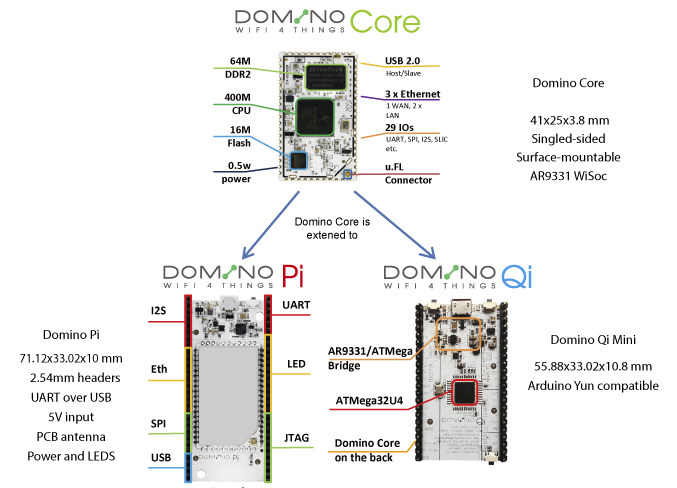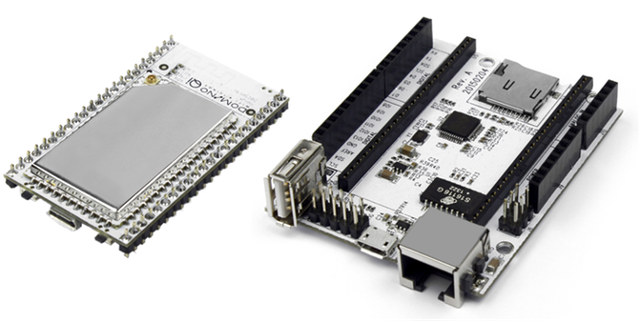The makers of GL.iNet OpenWRT compatible router have decided to build a module and two development boards based on Qualcomm Atheros AR9331 WiSoC. Domino.IO is composed of a Domino Core Wi-Fi module that can be used in your own project, but if also part of Domino Pi, a breadboard-friendly board featuring the module, and Domino Qi mini, a similar board with an Atmel ATMEga32U MCU making it compatible with Arduino Yun board.  Domino Core specifications:
Domino Core specifications:
- SoC – Qualcomm Atheros AR9331 MIPS processor @ 400MHz with
- System Memory – 64MB DDR3
- Storage – 16MB flash
- Connectivity – 802.11 b/g/n Wi-Fi with u.FL connector
- I/Os via half through holes – USB 2.0 host/slave, 3x Ethernet, 29 IOs including UART, SPI, I2S, SLIC, etc…
- Dimensions – 41 x 25 x 3.8 mm
Domino Pi and Qi mini summarized specifications are shown in the table below.
| Domino Pi | Domino Qi Mini | |
| Wi-Fi Module | Domino Core | |
| MCU | N/A | Atmel ATMega32U4 |
| USB | 1x micro USB for power and programming | |
| Header | 2x 28-pin headers | 2x 22-pin headers |
| Dimensions | 71.12 x 33.02 x 10 mm | 55.88 x 33.02 x 10.8 mm |
Both boards can be extended with single Ethernet, single USB, 3x USB + micro SD card, and SPI/JTAG add-on boards, with the latter useless not only for debugging, but also for unbricking the board in case you’ve deleted the complete flash.

Domino Pi also compatible with dual Ethernet, I2S audio, and LED add-on board, while Domini Qi mini can be inserted in an Domino Qi baseboard with Arduino compatible headers, a full sized USB port, and Ethernet Port, a micro SD slot, and more.
Domino core comes pre-installed with OpenWRT Linux based operating system, so you can use your favorite programming languages and tools such as Python, Node.js and npm, PHP, git, Lua, SSH, etc… You can also program the board via Ideino web interface.
The project is now up on Kickstarter, where developers aim to raise at least $30,000. Pledges start at $10 (early bird) with Domino Core, $19 should get you a Domino Pi Basic kit with Ethernet and USB add-on boards, $37 a Domini Qi Mini with the baseboard, and if you want the full package with both boards and all add-on boards, you’ll need to pledge $90. Shipping is $5, and delivery is scheduled for May 2015. You may also find more information on Domino.IO website.

Jean-Luc started CNX Software in 2010 as a part-time endeavor, before quitting his job as a software engineering manager, and starting to write daily news, and reviews full time later in 2011.
Support CNX Software! Donate via cryptocurrencies, become a Patron on Patreon, or purchase goods on Amazon or Aliexpress




